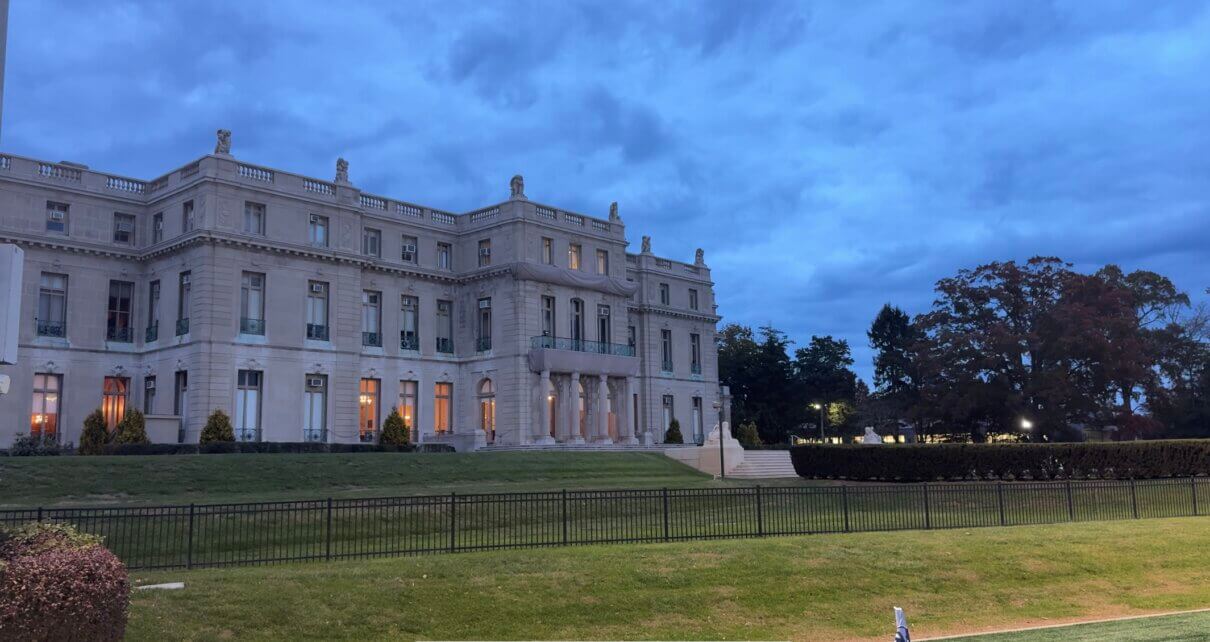Monmouth University’s most prominent building, even featured on the logo, is an iconic part of the university. It’s even an iconic part of popular culture, as The Great Hall served as Oliver “Daddy” Warbucks’ mansion in the 1982 film “Annie.” The Great Hall that stands today was built in 1929 however, it’s not the only mansion that has stood here on Shadow Lawn.
The original 52-room mansion at Shadow Lawn had multiple owners including Colonel Joseph Benedict Greenhut in 1915. Greenhut offered the residence to President Woodrow Wilson so it could serve as the summer White House and the planning center for Wilson’s second term campaign, as reported on the American Aristocracy website. According to the Monmouth University Website, President Wilson stayed at the estate from Sept. 1 to Nov. 8.
Hubert T. Parson, president of the F.W. Woolworth Company at the time, bought the Shadow Lawn estate in 1926 and in Jan. 1927, a fire destroyed the original mansion, one year after Parson, had spent one million dollars on its renovation, according to the Monmouth University website.
After the mansion was destroyed, Parson commissioned architect Horace Trumbaur and his assistant Julian Abele (the first African-American professional architect) to design the mansion that stands today. The home was finished in 1929 with 130 rooms, including an indoor swimming pool, bowling alley, theater, and a chapel.
No expense was spared in the creation of the mansion which cost the Parsons a total of $10.5 million when it was built. “The mansion features limestone quarried in Belford, Indiana (also used in the Empire State Building), fifty varieties of Italian marble, and steel and concrete framing to ensure the mansion would be fireproof,” according to the Monmouth University ‘Great Hall History’ portion of the website.
The chapel located on the lower level was taken from a Tudor Abby and brought here, to West Long Branch, said Jan Connolly, former director of Special Events and Programs, in “The Shadows of Shadow Lawn,” a documentary released in 2005. The documentary was produced by Monmouth Alumni Tom Hanley and Patrick Perrotto, which included a guided tour of The Great Hall, explaining its rich history.
The only people living in the residence when the Parson’s owned it was Hubert, his wife, Maysie, and Maysie’s unmarried sister Bertha Gasque, who acted as the housekeeper, overseeing the servants and staff, according the “The Shadows of Shadow Lawn.”
The documentary also notes that while The Great Hall is an extravagant mansion with plenty of event space, the Parson’s rarely had guests. Since the Parsons were considered “new money,” they were not well accepted in the West Long Branch social scene, especially by neighbors Murray and Leonie Guggenheim.
The Guggenheim’s lived across the street in what is now the Guggenheim Memorial Library and reportedly referenced the Parson house as being gaudy. Even going as far to throw a party the same night Maysie Parson planned to make her debut as a hostess at Shadow Lawn, and as a result, not one person showed up at the Parson’s estate, said Connolly, in the documentary’s guided tour through The Great Hall.
So, how did The Great Hall come to be a part of Monmouth University?
The short answer is that Hubert Parson lost a lot of his money due to the Wall Street Crash of 1929. To add to that, in 1932 Parson had reached the executive retirement age enforced by the Woolworth company of 60 years old, so after 12 years as president, he had to resign, as reported by the New York Times. Parson had started with the Woolworth organization as a bookkeeper, earning a salary of $12 dollars a week, eventually working his way up through the company through his 40 years there.
After no longer working for the Woolworth company, he was no longer able to afford his and Maysie’s lavish lifestyle and high taxes, so Shadow Lawn fell under municipal ownership in 1939 for $100.
It then became the campus for the Highland Manor School for Girls in 1942 when it relocated from Tarrytown, New York, as reported by The New York Times, until it was bought by then-Monmouth Junior College for $350,000 in 1955.
Eugene H. Lehman, founder of the Highland Manor School for Girls, became the university president in 1957 before stepping down to emeritus status soon thereafter.
The Great Hall officially became a National Historic Landmark in 1985.
Today, it is home to various administrative offices, the English department, classrooms, Parson’s Café, and is a beloved study space for all students.




